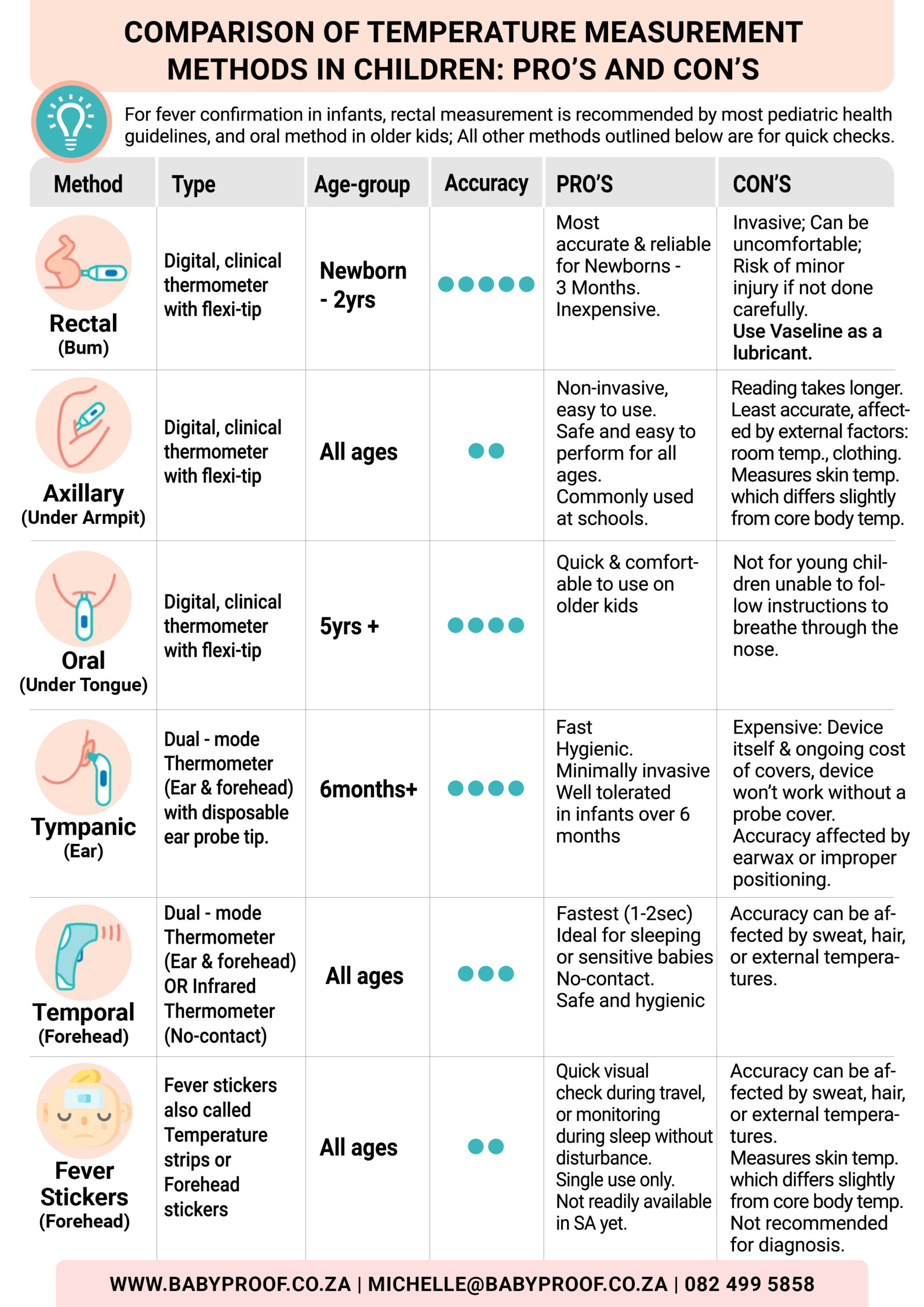Comprehensive Guide to Accurate Temperature Measurement Techniques for Children
Master Age-Specific Body Temperature Measurement Techniques for Maximum Accuracy:
- Newborn to 3 months → For the most dependable results, it is essential to use rectal thermometers. Alternatively, temporal (forehead) thermometers can provide quick screening options without discomfort.
- 3 months to 3 years → Although rectal thermometers are the gold standard for precision, temporal (forehead) and axillary (underarm) methods are more comfortable for young children.
(Shop now at my online store: Dreambaby Rapid Response Clinical Digital Thermometer with Flex-tip) – Ideal for rectal, underarm, and oral applications. - 4 to 5 years → If the child is cooperative, oral measurements are appropriate. For quick assessments, consider using temporal (forehead), tympanic (ear), or axillary (underarm) methods. Fever stickers can also be a handy option.
- 6 years and older → The preferred method is oral, as it provides a balance between accuracy and comfort; however, for rapid evaluations, temporal (forehead) or tympanic (ear) thermometers can be effective alternatives.
CLICK HERE TO DOWNLOAD A FREE PRINTABLE COPY
Why Accurate Temperature Measurements Are Crucial in Healthcare
Accurate temperature readings play a vital role in diagnosing various health conditions and monitoring overall wellness. This is particularly important in a diverse country like South Africa, where different environmental factors can greatly affect physiological responses. In clinical environments, healthcare professionals depend on precise temperature measurements to make informed decisions regarding treatment protocols. For instance, an inaccurate temperature reading could result in unnecessary treatments or delays in addressing serious health issues. Additionally, during community health initiatives, ensuring the reliability of temperature readings significantly enhances public health responses, especially during infectious disease outbreaks. Hence, the importance of accurate temperature measurement cannot be overstated, as it directly impacts patient outcomes and healthcare effectiveness.
The Significance of Continuous Body Temperature Monitoring for Health Maintenance
Monitoring body temperature is a foundational aspect of healthcare, especially in South Africa, where climatic conditions range vastly from coastal areas to mountainous regions. Elevated body temperatures often indicate underlying health problems, such as infections, which require immediate medical attention. Given South Africa’s diverse population and ecological environments, precise temperature monitoring is critical. For instance, individuals living at higher altitudes, such as the Drakensberg, may have different baseline temperatures due to environmental influences. This variability can significantly affect health assessments and treatment strategies. Therefore, understanding how to accurately measure and interpret body temperature is essential for effectively managing health conditions across various demographic groups.
In-Depth Examination of Temperature Measurement Techniques
In South Africa, common methods for measuring body temperature include oral (under the tongue), axillary (underarm), tympanic (ear), and rectal (bum) techniques. Each method has unique benefits and practical considerations that suit different circumstances. Oral thermometers are commonly found in homes and clinics, providing a good balance of convenience and reliability. Axillary measurements are often used in schools and childcare settings due to their non-invasive nature, despite being less precise. Rectal measurements, though used less frequently outside clinical environments, are considered the gold standard for accuracy, especially for vulnerable populations like infants or critically ill patients. Familiarity with each method and its appropriate applications is vital for effective health monitoring across South Africa.
Impact of Altitude on Temperature Measurements
The diverse altitudes found throughout South Africa present unique challenges for accurate temperature measurement. For example, in Johannesburg, situated approximately 1,753 meters above sea level, body temperature readings may differ compared to coastal cities such as Durban. Increased altitude can influence metabolic rates and thermoregulation, thereby requiring careful consideration when interpreting temperature readings. Healthcare providers must be aware of these variations when assessing patients from different regions. For instance, a fever in a patient from a high-altitude area may exhibit different characteristics than in someone from a lower elevation. Understanding these intricacies is essential for accurate health assessments and personalized patient care.
Technological Innovations Enhancing Temperature Monitoring
Recently, South Africa has witnessed significant technological advancements that improve the efficiency and accuracy of temperature monitoring. Innovations such as infrared thermometers and digital devices are becoming increasingly popular in both clinical and home settings. These devices provide rapid readings and often come equipped with user-friendly features, including backlit displays and memory functions for tracking historical data. Furthermore, smartphone-connected thermometers are emerging, allowing users to monitor temperature readings over time and easily share information with healthcare professionals. These advancements streamline the temperature measurement process and have the potential to improve health outcomes by facilitating timely medical interventions.
Detailed Steps for Measuring Oral Temperature Accurately
How to Effectively Take an Oral Temperature Reading
Taking an oral temperature reading is a simple yet precise process that requires placing the thermometer comfortably under the tongue and closing the mouth to ensure an accurate measurement. Before taking the reading, it is essential to confirm that the patient has not consumed any hot or cold foods or beverages within at least 15 minutes, as these can distort the results. Once the thermometer is securely positioned, wait for the device to signal that the reading is complete, typically through an audible beep. Educating patients and caregivers on this technique is crucial to ensure it is performed correctly, thereby preventing false readings. This method is widely practiced in South African households, providing families with easy access to monitor their health.
Advantages of Measuring Temperature Orally
Measuring temperature orally offers several benefits, making it a preferred option in many South African households and healthcare facilities. Firstly, this method is non-invasive, which significantly reduces the discomfort associated with alternative temperature-taking techniques. Secondly, it is user-friendly, allowing individuals to take readings without needing professional help. This convenience is especially beneficial for quick assessments at home, enabling families to monitor fever levels in both children and adults. Additionally, oral thermometers typically provide relatively quick results, usually within a minute or two, allowing for timely health decisions. In the fast-paced healthcare environments of South Africa, this efficiency is particularly advantageous.
Limitations and Important Considerations for Oral Temperature Measurement
While measuring temperature orally has numerous advantages, it also comes with certain limitations. This method may not be suitable for all patient demographics, particularly young children or individuals who have difficulty keeping the thermometer in place for the required duration. Factors such as recent food or drink consumption, smoking, or even breathing through the mouth can adversely affect the accuracy of readings. In South Africa, where environmental conditions can fluctuate significantly, outdoor temperatures may also impact readings if the thermometer is not used correctly. Therefore, when employing the oral method, it is crucial to consider these factors to achieve the most accurate results possible.
Understanding Axillary Temperature Measurement Techniques
How to Properly Conduct Axillary Temperature Measurements
The axillary method involves placing the thermometer in the armpit and ensuring that the arm is snug against the body for an accurate reading. This technique is widely practiced in South African schools and childcare facilities due to its safety and ease of use across various age groups. It is crucial to ensure that the skin is dry and that the thermometer is positioned correctly to obtain the best accuracy. This measurement may require slightly longer than oral methods, often taking several minutes. Educating caregivers and staff on proper technique is vital to ensure reliable temperature readings that effectively identify health issues in both children and adults.
Advantages of Axillary Temperature Measurement
Axillary temperature measurement provides several advantages, especially in public health settings throughout South Africa. A significant benefit is its non-invasive nature, making it safe for individuals of all ages, including infants and older adults. The simplicity of this method allows for quick execution in school health programs or at health fairs, where time may be limited. Additionally, axillary measurements are cost-effective, requiring fewer resources compared to advanced digital or infrared thermometers. This accessibility is particularly crucial in rural areas where healthcare resources may be scarce. The straightforward and safe nature of axillary measurements makes them an excellent choice for community health initiatives.
Factors Influencing the Accuracy of Axillary Temperature Measurements
Despite the clear advantages of the axillary method, several factors can impact the accuracy of temperature readings. Environmental conditions, such as high ambient temperatures or humidity levels prevalent in South Africa, can lead to elevated readings due to sweating, potentially misrepresenting a fever. Clothing can create insulation, hindering heat exchange and affecting results. Movement during the measurement process, particularly with children, can lead to inaccurate readings. Therefore, healthcare providers and caregivers must be aware of these factors and take proactive measures to mitigate their impact, such as ensuring that the arm remains close to the body and that the skin is dry before taking measurements.
Key Techniques for Accurate Rectal Temperature Measurement
How to Measure Rectal Temperature with Precision
Measuring rectal temperature accurately involves several careful steps to ensure both precision and comfort. First, it is crucial to lubricate the tip of the thermometer to facilitate gentle insertion. The thermometer should be inserted approximately an inch into the rectum, with care taken to hold it securely while waiting for the reading. This method is commonly used in South African hospitals due to its accuracy, particularly in critical care situations or when monitoring infants. Given its sensitivity, it is essential to perform the process gently and with the patient’s comfort in mind to maintain trust and cooperation, especially among vulnerable populations.
Benefits of Rectal Temperature Measurement
Rectal temperature measurements provide the most accurate readings compared to oral and axillary methods, making them ideal for critical care scenarios in South Africa. This level of accuracy is especially vital in emergency settings or when dealing with unresponsive patients, as healthcare professionals rely on precise temperature data to inform treatment decisions. Moreover, rectal thermometers are less affected by external variables like ambient temperature or recent oral intake, rendering them a reliable choice in clinical practice. In pediatric care, particularly for infants, rectal measurements deliver a definitive assessment of core body temperature, enabling timely and appropriate medical responses.
Considerations and Precautions When Using the Rectal Method
While the rectal method offers significant advantages, it also requires careful consideration and precautions. The insertion process can be uncomfortable, potentially leading to resistance from patients, especially in non-clinical settings. Therefore, clearly explaining the procedure and reassuring the patient is essential to gain their cooperation. Additionally, healthcare providers must adhere to strict hygiene protocols to prevent potential infections or injuries. Due to these concerns, rectal measurements are less frequently performed in home settings across South Africa. Nevertheless, understanding when and how to utilize this method is crucial for healthcare professionals to ensure the utmost care and accuracy in temperature monitoring.
Expert Recommendations on Temperature Measurement Methods: Oral, Axillary, or Rectal?
What Guidance Do Health Experts in South Africa Provide?
Health professionals in South Africa frequently recommend different temperature measurement methods based on various factors, including the patient’s age, condition, and the specific environment. For example, oral measurements are generally suggested for adults and older children who can securely hold the thermometer. Conversely, axillary readings may be preferred for quick assessments in schools or community health screenings. Rectal measurements are typically advised for infants or critically ill patients due to their superior accuracy. Below are some expert recommendations:
- For adults: Opt for oral or rectal readings to ensure accuracy.
- For young children: Choose axillary or rectal methods, based on the child’s cooperation.
- For infants: Rectal measurements are considered the gold standard.
- In school settings: axillary readings are often sufficient for quick checks.
- In emergencies: Prioritize rectal measurements for precise assessments.
These guidelines emphasize the importance of tailoring the temperature measurement method to fit the individual needs of the patient and the context in which care is delivered.
How Do Environmental Conditions in South Africa Influence Temperature Readings?
Environmental conditions in South Africa have a significant impact on temperature readings, requiring healthcare providers to consider contextual factors when interpreting data. For instance, in coastal regions where humidity levels are high, axillary temperature readings may appear elevated due to excessive sweating, leading to potential misdiagnosis. Similarly, in colder areas such as the Drakensberg, ambient temperatures can result in lower readings, compelling healthcare professionals to be vigilant in understanding local conditions. Experts recommend that practitioners adjust their interpretation of temperature data based on these environmental variables to ensure accurate assessments. This contextual awareness is essential for effective diagnosis and treatment.
What Best Practices Should Be Adopted for Temperature Measurement in South Africa?
Implementing best practices for temperature measurement is crucial in South Africa to ensure accurate and reliable readings. These practices include regular calibration of thermometers to maintain their accuracy, as poorly calibrated devices can yield misleading results. Additionally, healthcare providers should understand patient conditions and adapt their temperature measurement techniques accordingly. For instance, considering a patient’s hydration status can significantly affect readings. Providers should also educate patients and caregivers about the importance of proper measurement techniques, including the optimal times to take readings and the factors that may influence temperatures. By adhering to these best practices, healthcare professionals can significantly enhance the quality of care delivered.
How Do Cultural Beliefs Shape Temperature Measurement Preferences in South Africa?
Cultural beliefs can substantially influence temperature measurement preferences in South Africa. Different communities may prefer specific methods based on traditional practices or levels of comfort. For example, some cultures may lean towards non-invasive techniques like axillary measurements due to a preference for less intrusive approaches. Understanding these cultural nuances is vital for healthcare providers to deliver culturally sensitive care. Engaging with communities to educate them about the benefits and drawbacks of each temperature measurement method can foster trust and improve adherence to recommended practices. Moreover, respecting cultural beliefs while providing evidence-based recommendations can enhance patient cooperation and health outcomes.
What Challenges Are Associated with Implementing Different Temperature Measurement Methods in South African Health Facilities?
Implementing temperature measurement methods in South African health facilities presents several challenges, including resource availability and staff training. In rural areas, healthcare facilities may lack access to modern temperature-taking devices, limiting the effectiveness of temperature monitoring. Furthermore, continuous education and training are necessary to ensure staff proficiency in accurately utilizing various measurement methods. High patient volumes in urban clinics can also lead to time constraints, resulting in rushed assessments and potential inaccuracies. Addressing these challenges through targeted training programs and improved access to equipment is essential for enhancing temperature monitoring practices across South Africa’s diverse healthcare landscape.
Comparative Analysis of Oral, Axillary, and Rectal Temperature Measurement Techniques in South Africa
What Are the Key Differences Between These Measurement Methods?
The primary distinctions among oral, axillary, and rectal temperature measurement methods are based on accuracy, ease of use, and suitability for various age groups and settings. Oral thermometers provide reliable readings and are commonly used for adults and older children; however, they require patient cooperation, which may not always be feasible. Axillary temperature measurements are non-invasive and suitable for all ages, making them ideal for community screenings, though they may lack precision. Rectal measurements, while recognized as the most accurate, are less comfortable and may not be appropriate for all patients in non-clinical settings. Understanding these differences is essential for selecting the best method for each scenario.
Evaluating Accuracy and Reliability Across Different Measurement Methods
In South Africa, the accuracy and reliability of temperature readings can vary among different methods. Rectal measurements are generally regarded as the most accurate, closely reflecting core body temperature. Oral measurements follow, providing reliable readings when performed correctly, while axillary measurements tend to yield the least accurate results. This hierarchy of accuracy guides healthcare providers in their choices, particularly when assessing febrile patients or making critical care decisions. For instance, in emergency situations, rectal readings may be prioritized to ensure precise monitoring of patients’ conditions. Recognizing the limitations of each method can greatly enhance the quality of healthcare delivery in South Africa.
Assessing the Suitability of Each Method in the South African Context
The appropriateness of each temperature measurement method in South Africa depends on various factors, including the setting and the specific needs of the patient. In home environments, oral measurements are often favored for older children and adults due to their convenience. In contrast, axillary measurements might be standard in schools or during community health campaigns, where quick assessments are necessary. Rectal measurements, while ideal for precise monitoring in clinical settings, may be less appropriate for home use due to comfort concerns. Therefore, healthcare providers must carefully evaluate each situation, considering available resources and the patient’s condition to determine the most suitable method of temperature measurement.
Practical Considerations for Effective Temperature Measurement in South Africa
Available Equipment and Resources for Temperature Measurement in South Africa
The variety of equipment and resources available for temperature measurement in South Africa is extensive. From basic digital thermometers to advanced clinical devices, the options are plentiful. In urban hospitals, state-of-the-art technology is often employed, including infrared thermometers that facilitate quick and contactless measurements. Conversely, in rural settings, basic thermometers may be the only available option, which could affect the accuracy of readings. The availability and cost of these tools significantly influence the choice of method for healthcare practitioners throughout the country. Ensuring that healthcare facilities, particularly in underserved areas, have access to reliable equipment is crucial for effective patient care.
What Challenges Exist in Temperature Measurement Practices?
Healthcare providers in South Africa encounter numerous challenges concerning temperature measurement. Limited resources, especially in rural areas, can hinder access to accurate and reliable thermometers. Additionally, patient cooperation can be unpredictable, particularly in children or those with cognitive impairments, making accurate measurement difficult. Environmental factors unique to South Africa, such as extreme heat or cold, can also impact readings and complicate assessments. Overcoming these challenges involves employing strategies such as community education initiatives, improving access to temperature measurement equipment, and training healthcare providers on best practices.
How to Ensure Accurate Temperature Readings in South Africa?
Ensuring accurate temperature readings in South Africa involves several critical steps. First, healthcare providers should consistently evaluate their techniques and adhere to best practices for each measurement method. Regular calibration of thermometers is also essential to maintain accuracy. Educating patients and caregivers about the significance of proper technique—such as avoiding food intake before measurement and understanding environmental influences—can greatly enhance the reliability of assessments. Practitioners should also consider the unique environmental conditions of South Africa to adjust their interpretation of readings appropriately, ensuring comprehensive patient care.
Effective Strategies for Choosing the Best Temperature Measurement Method: Oral, Axillary, or Rectal?
How Can South Africans Make Informed Choices About Temperature Measurement?
Selecting the optimal method for temperature measurement in South Africa requires careful consideration of several factors. The patient’s age and health condition greatly influence the appropriate method. For example, infants may necessitate rectal measurements for accuracy, while older children might be more suited to oral or axillary methods. Additionally, the setting—whether clinical, home, or community health event—should guide the choice of measurement. South Africans can follow these strategies to make informed decisions:
- Assess the patient’s age and level of cooperation.
- Consider the urgency of the temperature assessment.
- Evaluate the available equipment and resources.
- Understand the environmental conditions that may impact readings.
By adhering to these guidelines, individuals can ensure they select a method that yields reliable results.
What Best Practices Should Be Implemented for Each Measurement Method in South Africa?
Establishing best practices for temperature measurement is essential across all methods utilized in South Africa. For oral measurements, always confirm that the patient has not consumed anything that could affect readings beforehand. For axillary measurements, keeping the arm close to the body and ensuring the skin is dry will yield more accurate results. Rectal measurements require careful handling and clear communication with the patient to minimize discomfort. Best practices for each method include:
- Regularly calibrate thermometers to maintain accuracy.
- Educate patients and caregivers about proper techniques.
- Consider environmental factors when interpreting results.
- Document findings accurately for ongoing health assessments.
These best practices will enhance the reliability of temperature measurements and improve health outcomes across South Africa.
How to Raise Public Awareness About Temperature Measurement in South Africa?
Public education on temperature measurement is vital for enhancing health literacy throughout South Africa. Healthcare providers should implement clear guidelines that outline the importance of accurate temperature readings and the methods for effectively measuring them. Community outreach programs, workshops, and health fairs can serve as platforms for educating the public about the various temperature measurement methods. Furthermore, utilizing local healthcare resources, such as clinics and hospitals, to disseminate information and provide demonstrations can enhance understanding. By focusing on practical applications and cultural relevance, healthcare professionals can foster a more informed public capable of effectively monitoring their health.
In Conclusion: Choosing the Most Suitable Temperature Measurement Method for South Africa
Key Takeaways on Temperature Measurement Techniques
Oral, axillary, and rectal temperature measurement methods each offer distinct advantages and limitations within South African healthcare. Understanding the unique characteristics of each method, including their accuracy, ease of use, and suitability for various age groups, is essential for effective health monitoring. By recognizing the environmental factors that may impact readings, healthcare professionals can make informed decisions that enhance patient care.
Recommendations for Healthcare Providers in South Africa
Healthcare providers in South Africa should carefully consider the specific needs of patients, including age and health status, when selecting temperature measurement methods. They must also remain mindful of available resources and the environmental context to ensure accurate assessments. Regular training and education on the latest best practices will further empower providers to deliver high-quality care in temperature monitoring.
Future Trends in Temperature Measurement Technology in South Africa
Future developments in temperature measurement may include the adoption of more advanced technology, such as smart thermometers that connect to mobile applications for tracking health metrics. Increased public education initiatives can further enhance health literacy regarding temperature measurement. Additionally, tailored approaches that consider South Africa’s unique cultural and environmental contexts will improve the effectiveness of healthcare delivery in temperature monitoring.
Rural vs Urban Considerations for Temperature Measurement in South Africa
The selection of temperature measurement methods can vary significantly between rural and urban settings in South Africa. Limited access to advanced equipment in rural areas may necessitate reliance on simpler methods like axillary readings. In contrast, urban facilities often have access to a broader range of technological options, allowing for more precise measurements. Addressing these disparities through targeted resource allocation and training is essential to ensure equitable healthcare access.
The Influence of Cultural Practices on Temperature Measurement Preferences
Cultural beliefs and practices inherently shape attitudes toward temperature measurement methods in South Africa. Understanding and respecting these beliefs is crucial for healthcare providers in delivering culturally sensitive care. By engaging with community leaders and incorporating culturally relevant practices into health education, providers can ensure that temperature measurement methods are both accepted and effectively utilized across varied cultural contexts.
Frequently Asked Questions (FAQs)
What is the most accurate method for measuring body temperature?
The rectal method is generally considered the most accurate for measuring body temperature, as it closely reflects core body temperature and is less influenced by external factors.
Can axillary temperature be trusted for diagnosis?
While axillary temperature is non-invasive and safe, it is typically less accurate than oral or rectal methods. However, it can provide useful information in non-critical settings.
How do I properly take an oral temperature reading?
To take an oral temperature, position the thermometer under the tongue, close the mouth, and wait for it to beep. Ensure no hot or cold food or drink has been consumed beforehand.
What factors can affect axillary temperature readings?
Factors such as ambient temperature, humidity, clothing, sweating, and movement can influence the accuracy of axillary temperature readings.
Is it safe to measure rectal temperature at home?
While rectal measurements are accurate, they can be uncomfortable. They are generally recommended for infants or in clinical settings rather than at home unless instructed by a healthcare professional.
What technology is available for temperature measurement in South Africa?
In South Africa, a variety of technologies are available, ranging from basic digital thermometers to advanced infrared devices that allow for quick, non-contact temperature measurements.
How often should thermometers be calibrated?
Thermometers should be calibrated regularly to ensure accuracy, ideally before significant use each season or at least once a year.
What should I do if my temperature reading is abnormal?
If a temperature reading is abnormal, especially if accompanied by other symptoms, it is advisable to seek medical advice for further evaluation and potential treatment.
Are there cultural preferences for temperature measurement methods in South Africa?
Yes, cultural beliefs can influence preferences for certain temperature measurement methods. Understanding these beliefs is essential for providing culturally sensitive healthcare.
How can I learn more about temperature measurement techniques?
You can learn more about temperature measurement techniques through local healthcare providers, community health workshops, and online resources dedicated to health education.
Discover our latest updates on Instagram!
The article Comprehensive Guide to Accurate Temperature Measurement Techniques for Children was first published at: https://www.babyproof.co.za
The Article Taking Temperature in Kids: Top Methods Compared Was Found On https://limitsofstrategy.com
The Article Temperature in Kids: Comparing the Best Measurement Methods First Appeared ON
: https://ad4sc.com











No responses yet